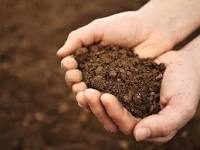 We spend all summer long admiring the plants and enjoying the harvest of our gardens. We spend a lot of time, energy and money to create the garden so that we can admire it. In order to have success with our garden, it is important that we stop to consider the soil into which we plant the plants we purchase and sow the the seeds we wish to grow.
We spend all summer long admiring the plants and enjoying the harvest of our gardens. We spend a lot of time, energy and money to create the garden so that we can admire it. In order to have success with our garden, it is important that we stop to consider the soil into which we plant the plants we purchase and sow the the seeds we wish to grow.
It takes an incredible amount of time to form the topsoil we have in our gardens. It can take anywhere from 400 to 3000 years to accumulate enough substances to make fertile topsoil. The length of time depends on the climate, for example in tropical areas it develops much faster where as soils under the glaciers take much longer.
The word soil derives from a Latin word ‘solum’ meaning earthy material in which plants grow. In otherwords it is the part of the earth crust in which humus is present. Humus is the organic residue from dead remains of plants and animals that are acted upon by a number of microorganisms working in the soil.
Humus plays an important role in soil by:
-providing nutrients to plants
-increasing the availability of minerals to plants
-retaining water
-making the soil porous
-binding sand particles
-increasing the rate of absortion in plants
Having this information, we can see that we have a role in maintaining this valuable resource. The accumulation of nutrients in the soil makes it more productive. We can help by adding organic matter to the soil in the way of digging in compost and leaves, and by planting and digging in cover crops such as legumes or clover.
Minimal disturbance of the soil allows the microorganisms to flourish under the surface, working to break down the organic matter. A common estimate is that one thimble full of topsoil may hold more than 20,000 microbial organisms. The largest of these organisms are earthworms and nemotodes and the smallest are bacteria, actinomycetes, algae and fungi, all beneficial to healthy topsoil.
When planting your garden beds, avoid as much as possible leaving exposed soil surfaces. Ater planting the plants you want in your garden, cover the remaining exposed soil by planting a ground cover or cover with a layer of organic mulch such as bark mulch. This planting practice will contribute to the organic matter and assist in retaining moisture in the soil.
As you begin to work in your garden this spring, take a moment to think about the importance of your garden soil and what you can do to keep it as healthy and fertile as possible.
I will conclude with a quote from Mark Cullen’s latest book Escape to Reality: “One thing I can predict, is this: if you prepare the soil well, you are far more likely to see your gardening dreams become a reality”
Mark Cullen with Ben Cullen. Escape to Reality: How the World is Changing Gardening and Gardening is Changing the World. Nimbus Publishing, Halifax Nova Scotia, 2018.
For more information about composting, check out an article in our blog entitled “Composting” https://www.nmgo.ca/composting/
